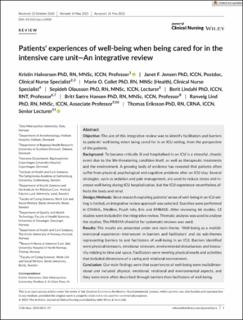| dc.contributor.author | Halvorsen, Kristin | |
| dc.contributor.author | Jensen, Janet Froulund | |
| dc.contributor.author | Collet, Marie O. | |
| dc.contributor.author | Olausson, Sepideh | |
| dc.contributor.author | Lindahl, Berit | |
| dc.contributor.author | Hansen, Britt Sætre | |
| dc.contributor.author | Lind, Ranveig | |
| dc.contributor.author | Eriksson, Thomas | |
| dc.date.accessioned | 2021-09-27T13:48:25Z | |
| dc.date.available | 2021-09-27T13:48:25Z | |
| dc.date.created | 2021-08-06T15:41:37Z | |
| dc.date.issued | 2021-06-22 | |
| dc.identifier.citation | Journal of Clinical Nursing (JCN). 2021, . | en_US |
| dc.identifier.issn | 0962-1067 | |
| dc.identifier.issn | 1365-2702 | |
| dc.identifier.uri | https://hdl.handle.net/11250/2783803 | |
| dc.description.abstract | Objective: The aim of this integrative review was to identify facilitators and barriers to patients’ well-being when being cared for in an ICU setting, from the perspective of the patients. Background: To become critically ill and hospitalised in an ICU is a stressful, chaotic event due to the life-threatening condition itself, as well as therapeutic treatments and the environment. A growing body of evidence has revealed that patients often suffer from physical, psychological and cognitive problems after an ICU stay. Several strategies, such as sedation and pain management, are used to reduce stress and increase well-being during ICU hospitalisation, but the ICU experience nevertheless affects the body and mind. Design; Methods: Since research exploring patients’ sense of well-being in an ICU setting is limited, an integrative review approach was selected. Searches were performed in CINAHL, Medline, Psych Info, Eric and EMBASE. After reviewing 66 studies, 12 studies were included in the integrative review. Thematic analysis was used to analyse the studies. The PRISMA checklist for systematic reviews was used. Results: The results are presented under one main theme, ‘Well-being as a multidimensional experience—interwoven in barriers and facilitators’ and six sub-themes representing barriers to and facilitators of well-being in an ICU. Barriers identified were physical stressors, emotional stressors, environmental disturbances and insecurity relating to time and space. Facilitators were meeting physical needs and activities that included dimensions of a caring and relational environment. Conclusion: Our main findings were that experiences of well-being were multidimensional and included physical, emotional, relational and environmental aspects, and they were more often described through barriers than facilitators of well-being. | en_US |
| dc.language.iso | eng | en_US |
| dc.publisher | Wiley | en_US |
| dc.relation.ispartofseries | Journal of Clinical Nursing; | |
| dc.rights | Navngivelse-Ikkekommersiell 4.0 Internasjonal | * |
| dc.rights.uri | http://creativecommons.org/licenses/by-nc/4.0/deed.no | * |
| dc.subject | Critical illnesses | en_US |
| dc.subject | Intensive care nursing | en_US |
| dc.subject | Intensive care patients | en_US |
| dc.subject | Nursing care | en_US |
| dc.subject | Patient experiences | en_US |
| dc.subject | Well-being | en_US |
| dc.title | Patients' experiences of well-being when being cared for in the intensive care unit—An integrative review | en_US |
| dc.type | Peer reviewed | en_US |
| dc.type | Journal article | en_US |
| dc.description.version | publishedVersion | en_US |
| dc.rights.holder | © 2021 The Authors. | en_US |
| cristin.ispublished | true | |
| cristin.fulltext | original | |
| cristin.qualitycode | 2 | |
| dc.identifier.doi | https://doi.org/10.1111/jocn.15910 | |
| dc.identifier.cristin | 1924455 | |
| dc.source.journal | Journal of Clinical Nursing (JCN) | en_US |
| dc.source.pagenumber | 1-17 | en_US |

